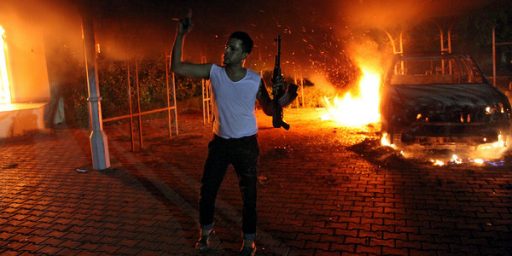Looking Beyond Al Qaeda
The Bush Administration is branching out in its efforts to defeat Islamist terror, moving beyond a military focus on al Qaeda into other areas.
Review May Shift Terror Policies (WaPo, A1)
The Bush administration has launched a high-level internal review of its efforts to battle international terrorism, aimed at moving away from a policy that has stressed efforts to capture and kill al Qaeda leaders since Sept. 11, 2001, and toward what a senior official called a broader “strategy against violent extremism.” The shift is meant to recognize the transformation of al Qaeda over the past three years into a far more amorphous, diffuse and difficult-to-target organization than the group that struck the United States in 2001. But critics say the policy review comes only after months of delay and lost opportunities while the administration left key counterterrorism jobs unfilled and argued internally over how best to confront the rapid spread of the pro-al Qaeda global Islamic jihad.
President Bush’s top adviser on terrorism, Frances Fragos Townsend, said in an interview that the review is needed to take into account the “ripple effect” from years of operations targeting al Qaeda leaders such as Khalid Sheik Mohammed, arrested for planning the Sept. 11 attacks, and his recently detained deputy. “Naturally, the enemy has adapted,” she said. “As you capture a Khalid Sheik Mohammed, an Abu Faraj al-Libbi raises up. Nature abhors a vacuum.”
The review marks the first ambitious effort since the immediate aftermath of the 2001 attacks to take stock of what the administration has called the “global war on terrorism” — or GWOT — but is now considering changing to recognize the evolution of its fight. “What we really want now is a strategic approach to defeat violent extremism,” said a senior administration official who described the review on the condition of anonymity because it is not finished. “GWOT is catchy, but there may be a better way to describe it, and those are things that ought to be incumbent on us to look at.”
In many ways, this is the culmination of a heated debate that has been taking place inside and outside the government about how to target not only the remnants of al Qaeda but also broader support in the Muslim world for radical Islam. Administration officials refused to describe in detail what new policies are under consideration, and several sources familiar with the discussions said some issues remain sticking points, such as how central the ongoing war in Iraq is to the anti-terrorist effort, and how to accommodate State Department desires to normalize a foreign policy that has stressed terrorism to the exclusion of other priorities in recent years.
[…]
“No question this is the next stage, the phase two,” another senior counterterrorism official said. “We are coming to the point of decisions.”
Much of the discussion has focused on how to deal with the rise of a new generation of terrorists, schooled in Iraq over the past couple years. Top government officials are increasingly turning their attention to anticipate what one called “the bleed out” of hundreds or thousands of Iraq-trained jihadists back to their home countries throughout the Middle East and Western Europe. “It’s a new piece of a new equation,” a former senior Bush administration official said. “If you don’t know who they are in Iraq, how are you going to locate them in Istanbul or London?”
Another key aspect is likely to be the addition of public diplomacy efforts aimed at winning over Arab public sentiment, and State Department official Paul Simons said at a congressional hearing earlier this month that the “internal deliberative process” was broadly conceived to encompass everything from further crackdowns on terrorist financing networks to policies aimed at curbing the teaching of holy war against the West and other “tools with respect to the global war on terrorism.”
Of course, the administration is already doing all these things and has been since the beginning. To characterize this as “new” is puzzling. At most, this is a change of emphasis.
This is interesting, however:
In general, current and former officials familiar with the discussions said, the challenge is to reorient U.S. efforts when the immediate threat from al Qaeda seems to have receded, though it is still far from disappearing. Osama bin Laden and other top lieutenants remain at large, but many U.S. experts appear to now agree with the assessment of Pakistan President Pervez Musharraf, who told a reporter recently that “we have broken the back of al Qaeda.”
“No doubt al Qaeda as an organization has been destroyed,” Afghan President Hamid Karzai told Washington Post reporters and editors last week. “No doubt it is no longer capable to launch the kind of attacks that they did on all of us a few years ago. Their capability is limited only to sporadic individual acts, suiciders and things like that.”
Until recently, the Bush administration resisted any broadening of its mission against al Qaeda, insisting on what Townsend once called a “decapitation” strategy. The policy review marks what many experts regard as a belated shift. “The administration has appropriately taken the broad view,” said an intelligence official who had urged the review. “It’s not going to be a matter of just trying to roll up more al Qaeda guys. What we still know as the al Qaeda organization — they’ve taken a terrible beating.”
But even that notion remains controversial when assessing the continuing threat from al Qaeda will shape the policy against it. “I just don’t accept the idea that the whole organization is completely gone and morphed into an amorphous global jihad movement,” said Kenneth Katzman, a terrorism analyst at the Congressional Research Service. “They could still try to reconstitute the centralized structure of before 9/11.”
The risks of doing that are too high, though. A decentralized enemy should be less capable of mounting a massive attack. At the same time, it is much harder to destroy.





I think you may have this backwards as suggested by what you choose not to include. What’s interesting is that the administration is thinking about counterterrorism. That means that the purge is probably nearing completion. The lack of emphasis on al Qaeda, on developing assets and expertise, and on filling vacancies is already known. Also interesting is the judgment of the effects of the flypaper which is something of an admission. What’s not new is the idea that the threat from a post-Taliban al Qaeda was overblown. The mere fact of going to war with Iraq when we did is proof in and of itself that there was little do be done with al Qaeda. Now it’s just convenient to start fessin’ up.
Since “violent extremism” is an even older and less tractable set of human behaviors than “terrorism” itself, what we have here is a budgetary gravy train stretching well past the sunset of the careers of all concerned. THAT is the real Grand Strategy here.
Er — no, Jim H.
The grand strategy is pre-emption. In this case, suppressing terrorism by combating the “older and less tractable set of human behaviors” that gives rise to it.
The goal is to give the region enough breathing room that it can develop economically and socially and eventually make “violent extremism” less of a threat to the institutions on which stable societies depend.
Er-no, Mr. McGehee
The goal here is to give the conservative-nazi movement in the good old USA enough breathing room to continue dominating any real freedoms the American people have left. A good example
of this is available , just look into how the administration propaganda machine has developed
the blog propagandist in it own employ to abuse
what it calls “the media” into submission. do not look too closely at the bush crime family
there are too many other threats and emergencies
to keep an eye on
Speaking of extremists…
There is a similar debate over at Jihad-Watch.
See my two cents over there:
STRATEGIC THINKING AKA COMMON SENSE
The key phrase in this reassessment is strategic thinking or in less lofty terms common sense. To win any war, you must know who the enemy is and the ideology that drives it.
[…]
Read More
It surprises me that White House strategists have not thought of the obvious next step in the Global War on Terror – i.e. to discover a genetic basis for “violent extremist” behaviour. Some well-placed funding could easily identify the chromosomes that lead to such behaviour and tailor the findings to whoever Bush and Co. want to take out next. For example, the Iranians. Or maybe, if worse comes to worst, all semites but not Israelis (due to their superior capacity for adaptation to Christian values). This approach would get around “moral qualms” objections (“they may be kids now, but later…”), justify torture, guarantee funding for the military and scientific industries, and provide a sound basis for war many years into the future. Just an idea…